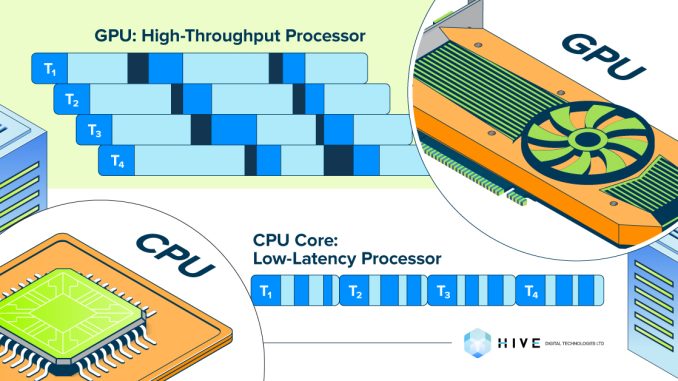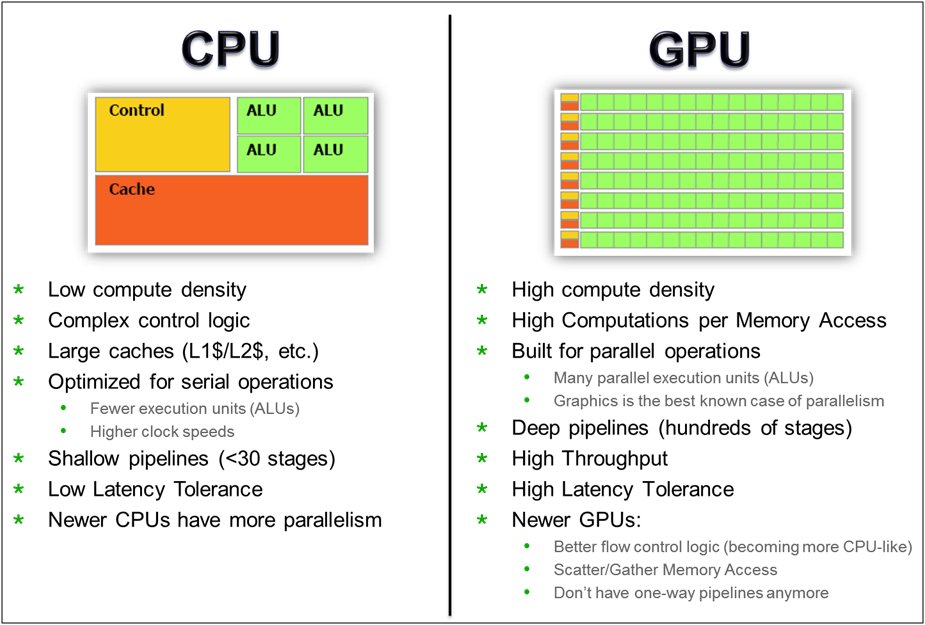
In the world of computing, two acronyms frequently pop up: CPU and GPU. But what exactly do they mean, and why should you care about the difference? Whether you’re a gamer, a professional content creator, or just someone looking to build or buy a new computer, understanding the roles and distinctions of these components is crucial.
Understanding CPUs
Definition and Basic Function
The Central Processing Unit (CPU) is often referred to as the “brain” of the computer. It handles most of the processing tasks, executing instructions from programs by performing basic arithmetic, logic, control, and input/output operations.
History and Evolution
CPUs have come a long way since their inception. From the early days of simple processors handling a few thousand instructions per second, modern CPUs now execute billions of instructions per second. This evolution has been driven by advancements in semiconductor technology and microarchitecture.
Core Components of a CPU
A CPU is composed of several key components:
- Arithmetic Logic Unit (ALU): Performs arithmetic and logical operations.
- Control Unit (CU): Directs the operation of the processor.
- Cache: Small, fast memory that stores copies of frequently accessed data.
- Registers: Small storage locations within the CPU for immediate data processing.
How CPUs Process Data

CPUs process data through a cycle known as the fetch-decode-execute cycle. They fetch an instruction from memory, decode what action is required, and then execute that action. This process is repeated millions of times per second.
Understanding GPUs
Definition and Basic Function
The Graphics Processing Unit (GPU) is designed to handle graphics rendering tasks. Unlike CPUs, which are optimized for single-threaded performance, GPUs excel at parallel processing, making them ideal for rendering images, videos, and animations.
History and Evolution
Initially developed to accelerate the rendering of 3D graphics in games, GPUs have evolved to become powerful processors capable of handling complex computations required in various fields, including artificial intelligence and scientific research.
Core Components of a GPU
A GPU consists of:
- Shaders: Small processing units that perform calculations related to rendering graphics.
- Texture Units: Handle texture mapping.
- Render Output Units (ROPs): Manage the final stage of rendering pixels to the screen.
- VRAM (Video RAM): Dedicated memory for storing graphics data.
How GPUs Process Data
GPUs process data in parallel, allowing them to handle thousands of operations simultaneously. This makes them highly efficient for tasks that can be divided into smaller, concurrent operations.
Key Differences Between CPU and GPU
Architectural Differences
CPUs are designed with a few cores optimized for sequential processing, while GPUs have hundreds or thousands of smaller cores for parallel processing. This fundamental difference shapes their respective strengths and weaknesses.
Performance Differences
For tasks requiring single-threaded performance and complex decision-making, CPUs outperform GPUs. However, for tasks that benefit from parallel processing, such as graphics rendering or data crunching in AI models, GPUs are far superior.
Task Specialization
CPUs are versatile and can handle a wide range of tasks. In contrast, GPUs are specialized for tasks that involve large-scale parallel processing, making them less flexible but extremely efficient for specific applications.
CPU Use Cases
Everyday Computing Tasks
For everyday tasks like web browsing, office applications, and light gaming, CPUs are more than capable. They manage the operating system, run applications, and ensure smooth multitasking.
Gaming
While GPUs are crucial for rendering high-quality graphics, the CPU plays a significant role in-game performance, especially in managing game logic, physics calculations, and AI behavior.
Professional Applications
In professional environments, CPUs handle complex computations required in software development, data analysis, and digital content creation. They are essential for running productivity software and managing large datasets.
GPU Use Cases
Graphics Rendering
GPUs are indispensable for rendering high-resolution graphics in games, virtual reality, and professional design software. They ensure smooth frame rates and realistic visual effects.
Machine Learning and AI
In the realm of artificial intelligence, GPUs accelerate the training of neural networks, enabling faster and more efficient processing of large datasets compared to CPUs.
Video Editing and Rendering
For video editing professionals, GPUs provide the necessary power to handle high-definition video rendering and real-time editing, significantly reducing production times.
How CPUs and GPUs Work Together
Integration in Modern Systems
Modern computers often feature both CPUs and GPUs, each complementing the other’s strengths. While the CPU manages overall system performance and multitasking, the GPU handles specific tasks that benefit from parallel processing.
Examples of CPU and GPU Collaboration
In gaming, the CPU manages game logic and AI, while the GPU renders graphics. In data science, the CPU handles data preprocessing, and the GPU performs intensive computations during model training.
Choosing Between CPU and GPU
Determining Your Needs
When building or upgrading a computer, consider what tasks you’ll be performing most frequently. For general computing, a strong CPU is essential. For tasks like gaming or machine learning, investing in a powerful GPU is crucial.
Budget Considerations
CPUs and GPUs come in various price ranges. Balancing your budget with your performance needs is key. Sometimes, a mid-range CPU paired with a high-end GPU can offer the best performance for specific tasks.
Future-Proofing Your Setup
Technology evolves rapidly, so consider future-proofing your setup. Investing in a high-performance CPU and GPU today can save you from frequent upgrades and ensure your system remains capable of handling new applications and games.
Latest Trends in CPU and GPU Technology
Recent Advancements in CPU Technology
Recent CPU advancements include increases in core counts, improvements in power efficiency, and the integration of AI accelerators to enhance performance in machine learning tasks.
Recent Advancements in GPU Technology
GPUs have seen significant improvements in ray tracing, AI-driven image enhancement, and increased memory bandwidth, all contributing to more realistic graphics and faster computations.
Emerging Technologies and Future Outlook
Looking ahead, both CPUs and GPUs are expected to become more integrated with AI capabilities, offering even greater performance and efficiency for a wide range of applications.
Common Misconceptions
CPU vs GPU for Gaming
A common misconception is that a powerful GPU alone guarantees good gaming performance. However, a balanced system with both a strong CPU and GPU is essential for optimal gaming experience.
CPU vs GPU for Professional Work
For professional tasks like video editing and 3D rendering, many believe a high-end GPU is all that’s needed. However, a capable CPU is also necessary to handle software operations and data management.
Overclocking Myths
Overclocking can boost performance, but it’s often misunderstood as a risk-free way to get more power. In reality, it can lead to instability and reduced hardware lifespan if not done correctly.
Performance Benchmarks
Popular CPU Benchmarks
Benchmarks like Cinebench, Geekbench, and PassMark evaluate CPU performance, providing insights into single-threaded and multi-threaded capabilities.
Popular GPU Benchmarks
GPU benchmarks such as 3DMark, Unigine Heaven, and FurMark measure graphics performance, helping users compare different models based on rendering speed and quality.
How to Interpret Benchmark Results
Understanding benchmark results involves looking at scores in context. Higher scores indicate better performance, but real-world application performance may vary based on specific use cases.
Energy Consumption and Efficiency
Power Usage of CPUs
CPUs vary in power consumption, with higher-end models typically using more power. Efficiency improvements in recent models help reduce energy usage while maintaining performance.
Power Usage of GPUs
GPUs, especially high-end models, can be power-hungry. Manufacturers have made strides in improving efficiency, but powerful GPUs still require substantial power supplies.
Environmental Considerations
Energy-efficient CPUs and GPUs not only lower electricity bills but also reduce environmental impact. Opting for components with lower power consumption can contribute to a greener computing setup.
Overclocking: Pros and Cons
What is Overclocking?
Overclocking involves increasing the clock speed of a CPU or GPU beyond its factory settings to achieve higher performance.
Benefits of Overclocking CPUs and GPUs
The main advantage is enhanced performance, allowing for smoother gaming, faster computations, and better overall system responsiveness.
Risks and Drawbacks
Overclocking can lead to increased heat output and potential system instability. Without adequate cooling, it can shorten the lifespan of components and void warranties.
Maintaining Your CPU and GPU
Cooling Solutions
Effective cooling is vital for maintaining optimal performance and longevity of CPUs and GPUs. Options include air coolers, liquid coolers, and enhanced case ventilation.
Regular Maintenance Tips
Regularly cleaning dust from components, applying fresh thermal paste, and ensuring proper airflow can help maintain performance and prevent overheating.
Upgrading Considerations
When upgrading, consider compatibility with existing components, potential performance gains, and whether a new CPU or GPU will meet future needs.
Conclusion
Understanding the differences between CPUs and GPUs is essential for making informed decisions when building or upgrading a computer. Each has its strengths and ideal use cases, and together they create powerful and efficient computing systems. Whether you’re a gamer, a professional, or a casual user, choosing the right balance of CPU and GPU can significantly impact your computing experience.
FAQs
- Which is more important for gaming, a CPU or a GPU?
- Both are important, but a powerful GPU typically has a greater impact on gaming performance. However, a balanced system with a capable CPU is essential for optimal results.
- Can a GPU replace a CPU?
- No, GPUs cannot replace CPUs. They serve different purposes and work together to handle various tasks in a computer system.
- How often should I upgrade my CPU and GPU?
- Upgrading every 3-5 years is a common practice, but it depends on your specific needs and the advancements in technology during that time.
- Are integrated graphics sufficient for basic tasks?
- Yes, integrated graphics are usually sufficient for basic tasks like web browsing, office applications, and media playback.
- What should I prioritize for a balanced PC build?
- Prioritize a strong CPU and GPU combination that fits your budget and meets your performance needs. Ensure compatibility with other components and consider future-proofing.


Leave a Reply